

Who Gets to Graduate? Photo.
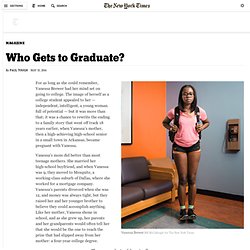
FW- Homework. Completion begins and ends in the classroom. The goals of the Completion Agenda in the community college—to double the number of students who complete a one-year certificate, an associate degree or who transfer to another college or university to complete a credential—is the reform movement of this decade and perhaps the next.
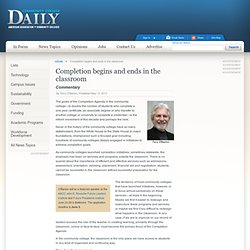
Never in the history of the community college have so many stakeholders, from the White House to the State House to major foundations, championed such a focused goal including hundreds of community colleges deeply engaged in initiatives to address completion goals. As community colleges launched completion initiatives, sometimes statewide, the emphasis has been on services and programs outside the classroom.
There is no quarrel about the importance of efficient and effective services such as admissions, assessment, orientation, advising, placement, financial aid and registration; students cannot be successful in the classroom without successful preparation for the classroom. Key leaders concur. A strategy that narrows academic achievement gap by 63 percent. Americans don't like to talk about social class.
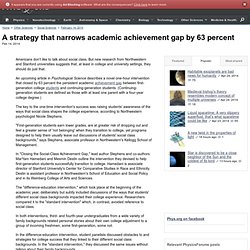
But new research from Northwestern and Stanford universities suggests that, at least in college and university settings, they should do just that. www.aspeninstitute.org/sites/default/files/content/docs/pubs/Creating%20A%20Faculty%20Culture%20of%20Student%20Success. STUDY: Too Few Colleges Embrace Successful Educational Practices - Community College Week - The independent voice servicing community, junior and technical colleges.
By Paul Bradley A growing body of research has identified about a dozen policies and practices that can improve graduation and retention rates.
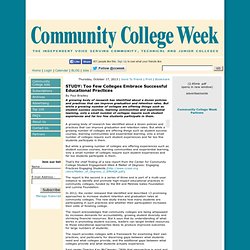
But while a growing number of colleges are offering things such as student success courses, learning communities and experiential learning, only a small number of colleges require such student experiences and far too few students participate in them. But while a growing number of colleges are offering experiences such as student success courses, learning communities and experiential learning, only a small number of colleges require such student experiences and far too students participate in them. Higher-Education Groups Unveil Alternative to Federal Student-Success Measures - Students. By Katherine Mangan Six major higher-education associations have teamed up to develop a new method of measuring student success that provides a more comprehensive look at how students progress through college and how many of them eventually graduate.

Beginning on Monday, colleges seeking a voluntary alternative to the federal government's method of calculating completion can sign on to the Student Achievement Measure. Using information from the National Student Clearinghouse, they will be able to post data that includes graduation rates for transfer students and, for two-year colleges, those attending part time. Students who are still enrolled at the end of the tracking period will also be included. 28516 01Intro.indd. NCAT: How to Structure a Math Emporium. In redesigning introductory mathematics courses, NCAT’s partner institutions have found that the Emporium Model has consistently produced spectacular gains in student learning and impressive reductions in instructional costs.

Two different versions of the Emporium Model have been successful. In both versions, mandatory attendance (e.g., a minimum of 3 hours weekly in the emporium) ensures that students spend sufficient time on task and receive on-demand assistance. In both versions, mandatory weekly group meetings enable instructors to follow up where testing has identified weaknesses or emphasize particular applications. Group activities help build community among students and with instructors. Flexible Attendance: Mandatory lab hours may be completed at the student’s convenience. Fixed Attendance: Mandatory lab hours are scheduled by the institution for student cohorts. Jackson State Community College: Basic Math, Elementary Algebra and Intermediate Algebra.
A Stronger Nation through Higher Education. As we at Lumina Foundation prepared to release this, the fourth edition of our signature report, A Stronger Nation through Higher Education, I found myself pondering a fundamental question, a query embedded in the title itself: Just what do we mean by “stronger?”
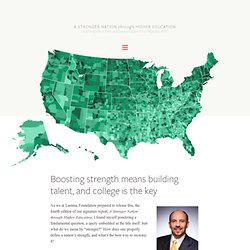
How does one properly define a nation’s strength, and what’s the best way to increase it? These are important questions — ones that we’ve addressed intuitively, I think, but perhaps not explicitly. So let’s be clear: At its core, the strength of this nation — or any nation — is its people, the sum total of talents, skills and abilities inherent in its citizenry. Only with sufficient talent, and the right kinds of talent, can a nation truly succeed. Talent development, then, must be America’s prime objective, and it’s not a task we can tackle by conducting business as usual. But we needn’t look beyond our own borders to find compelling arguments for boosting postsecondary attainment. Study debunks community college 'penalty' The so-called “community college penalty,” which refers to the notion that students who attend community college before transferring to a four-year institution are less likely to earn a bachelor’s degree than their peers who bypass community college, doesn’t exist.
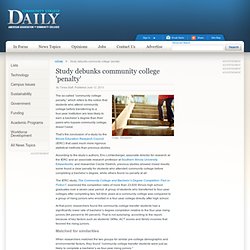
That’s the conclusion of a study by the Illinois Education Research Council (IERC) that used much more rigorous statistical methods than previous studies. According to the study’s authors, Eric Lichtenberger, associate director for research at the IERC and an associate research professor at Southern Illinois University Edwardsville, and researcher Cecile Dietrich, previous studies showed mixed results: some found a clear penalty for students who attended community college before completing a bachelor’s degree, while others found no penalty at all.
The IERC study, The Community College and Bachelor’s Degree Completion: Fact or Fiction? Completion begins and ends in the classroom. The goals of the Completion Agenda in the community college—to double the number of students who complete a one-year certificate, an associate degree or who transfer to another college or university to complete a credential—is the reform movement of this decade and perhaps the next.
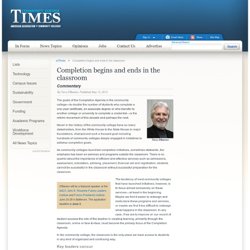
Never in the history of the community college have so many stakeholders, from the White House to the State House to major foundations, championed such a focused goal including hundreds of community colleges deeply engaged in initiatives to address completion goals. As community colleges launched completion initiatives, sometimes statewide, the emphasis has been on services and programs outside the classroom. Jeffrey Selingo on Curing the College Dropout Syndrome. Book Chat Talking with authors about their work. Arizona St. and Knewton's grand experiment with adaptive learning. Stop me if you already know this one.

You are explaining how to solve quadratic equations to a classroom full of 18-year-olds. Narrating as you map out the steps on a whiteboard, you occasionally scan the room for raised hands. No questions before you move on? Of course you won’t find out until later, grading the tests, that in fact there was confusion in the poker-faced audience. 7 Steps to Success at Community College. Many start community college. Few are graduated two, three, or even six years later. Community colleges are raising success rates by helping first year students connect with professors and classmates, concludes "A Matter of Degrees," which is based on surveys by the Center for Community College Student Engagement at the University of Texas—Austin.
[Get tips on how to pay for college.]